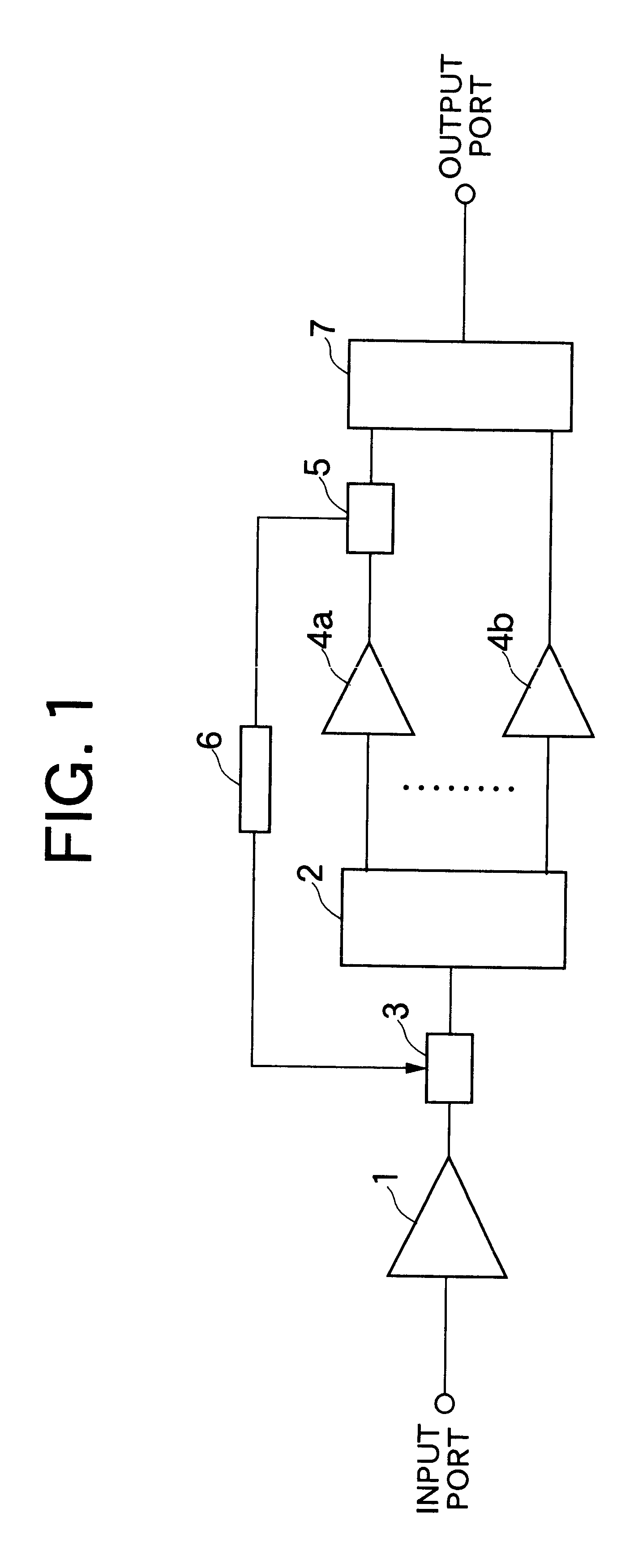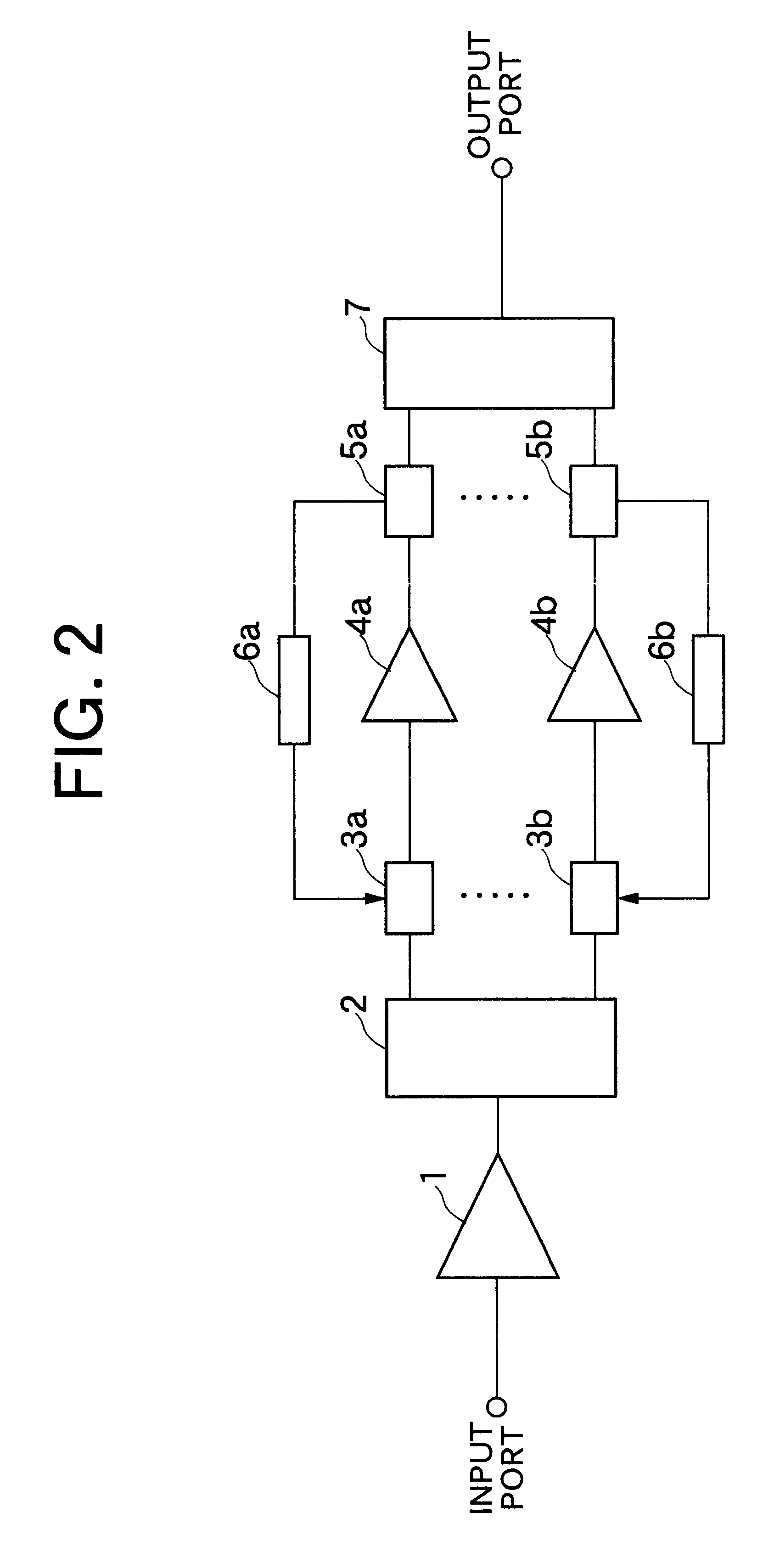Optical amplification repeater and optical amplification repeating and transmitting system
a technology of optical amplification and transmitting system, applied in the field of optical amplification repeater and optical amplification repeating and transmitting system, can solve the problems of affecting the quality of communication, requiring troublesome procedures, and coping with the increase or decrease of wavelengths
- Summary
- Abstract
- Description
- Claims
- Application Information
AI Technical Summary
Problems solved by technology
Method used
Image
Examples
embodiment 1
FIG. 1 is a block diagram showing a configuration or structure of an optical amplifying repeater apparatus according to a first embodiment of the present invention. In FIG. 1, reference numeral 1 denotes a first fixed-gain optical amplifier, numeral 2 denotes an optical demultiplexer, numeral 3 denotes an adjustable optical attenuator, numerals 4a; 4b denote fixed-gain optical amplifiers #1-#n, numeral 5 denotes a monitoring light branching device, numeral 6 denotes an adjustable attenuator control circuit, and reference numeral 7 denotes an optical multiplexer.
Next, operation of the optical amplifying repeater apparatus will be described. Referring to FIG. 1, the first fixed-gain optical amplifier 1 is designed to amplify wavelength-multiplexed light signals of n bands, i.e., wavelengths .lambda.11 to .lambda.1n (first band), .lambda.21 to .lambda.2n (secondband), . . . , .lambda.n1 to .lambda.nn (n-th band) with a predetermined gain.
In the present state of the art, such a system h...
embodiment 2
FIG. 2 is a block diagram showing a configuration of the optical amplifying repeater apparatus according to a second embodiment of the invention. In FIG. 2, reference numeral 1 denotes a first fixed-gain optical amplifier, numeral 2 denotes an optical demultiplexer, numerals 3a; 3b denote adjustable optical attenuators #1-#n, respectively, numerals 4a; 4b denote fixed-gain optical amplifiers #1-#n, respectively, numerals 5a; 5b denote monitoring light branching devices #1-#n, respectively, numerals 6a; 6b denote adjustable attenuator control circuits #1-#n, respectively, and reference numeral 7 denotes an optical multiplexer.
Next, operation of the optical amplifying repeater apparatus according to the instant embodiment will be described. Referring to FIG. 2, the first fixed-gain optical amplifier 1 is designed to amplify wavelength-multiplexed light signals of n bands, i.e., wavelengths 11 to .lambda.1n (first band), .lambda.21 to .lambda.2n (second band), . . . , .lambda.n1 to .la...
embodiment 3
FIG. 3 is a block diagram showing a configuration or structure of an optical amplifying repeater apparatus according to a third embodiment of the invention. In FIG. 3, reference numeral 8 denotes an optical fiber, numeral 9 denotes an optical coupling device and reference numeral 10 denotes a pumping light source. In the figure, components same as or equivalent to those of the optical amplifying repeater apparatus described previous by reference to FIG. 2 are denoted by like reference symbols, and description thereof is omitted.
Operation of the optical amplifying repeater apparatus according to the instant embodiment will be described. In the optical amplifying repeater apparatus now under consideration, the pumping light source 10 sends out pumping light injected to the optical fiber 8 by way of the optical coupling device 9 for effectuating the stimulated Raman amplification. Since the stimulated Raman amplifier is difficult to be subjected to gain saturation when compared with th...
PUM
 Login to View More
Login to View More Abstract
Description
Claims
Application Information
 Login to View More
Login to View More - Generate Ideas
- Intellectual Property
- Life Sciences
- Materials
- Tech Scout
- Unparalleled Data Quality
- Higher Quality Content
- 60% Fewer Hallucinations
Browse by: Latest US Patents, China's latest patents, Technical Efficacy Thesaurus, Application Domain, Technology Topic, Popular Technical Reports.
© 2025 PatSnap. All rights reserved.Legal|Privacy policy|Modern Slavery Act Transparency Statement|Sitemap|About US| Contact US: help@patsnap.com



